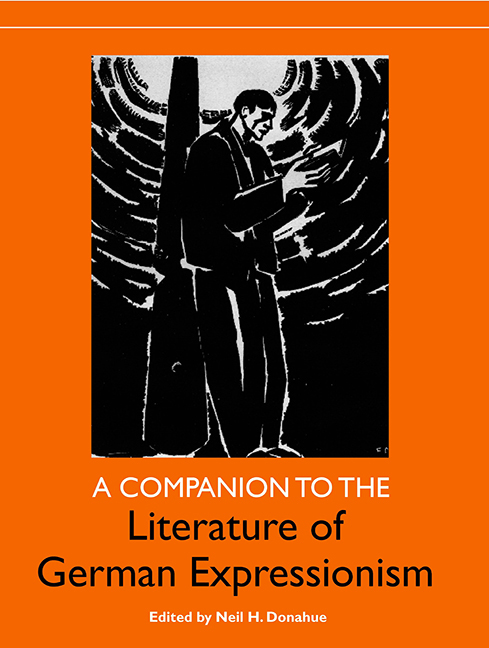Book contents
- Frontmatter
- Contents
- List of Illustrations
- Preface and Acknowledgments
- Chronology
- Introduction
- Philosophical Background
- Prose
- Poetry
- Drama
- Interdisciplinary
- 10 Intimate Strangers: Women in German Expressionism
- 11 Expressionism and Cinema: Reflections on a Phantasmagoria of Film History
- Select Bibliography
- Notes on the Contributors
- Index
11 - Expressionism and Cinema: Reflections on a Phantasmagoria of Film History
from Interdisciplinary
Published online by Cambridge University Press: 28 April 2017
- Frontmatter
- Contents
- List of Illustrations
- Preface and Acknowledgments
- Chronology
- Introduction
- Philosophical Background
- Prose
- Poetry
- Drama
- Interdisciplinary
- 10 Intimate Strangers: Women in German Expressionism
- 11 Expressionism and Cinema: Reflections on a Phantasmagoria of Film History
- Select Bibliography
- Notes on the Contributors
- Index
Summary
No other film in world cinema is as closely identified with a particular movement or style as Das Kabinett des Dr. Caligari (The Cabinet of Dr. Caligari, 1920) is with Expressionism. Similarly, no other film has been invoked so frequently to make sense of Weimar culture and society and, even more problematically, to shed light on the mass appeal of National Socialism. Caligari's almost mythical status continues in competing accounts of its production and reception, contradictory claims about its relevance to the evolution of form and meaning in silent cinema, and highly speculative assertions about its place in German film history (Budd 1990). In the same way that Caligari denies the comforts of closure, the Expressionist film in general also resists easy definition. However, its elusiveness in terms of critical category has not precluded its continuing resonance in film history and cultural criticism, as well as in later filmic and multi-media practices. As regards the study of Weimar culture, the inevitable slippages in meaning can be seen most clearly in the two “imaginaries” identified with “Weimar cinema” and “Expressionist film” (Elsaesser 2000, 34) and their respective contribution to the historical, theoretical, and filmic reconstruction of German modernity.
Designed by Walter Röhrig, Hermann Warm, and Walter Reimann, Caligari is known best for its painted backdrops, false perspectives, skewed angles, dramatic lighting, and graphic effects (Robinson 1997). As told by screenwriters Hans Janowitz and Carl Mayer, the story follows the mysterious Dr. Caligari, who arrives at the fairground of a small town with the somnambulist Cesare. A series of murders strikes fear among the towns-people and has a devastating effect on three young friends caught in a love triangle, with one of the men, Allan, killed and the woman, Jane, abducted by the somnambulist. The framing story, which places the man's best friend Francis in an insane asylum, leaves it open whether he is the victim of a mad doctor or his own delusions. Recent findings suggest that the film's complicated narrative structure was the product of a series of deliberate artistic and economic decisions. For that reason, Caligari cannot be reduced to an expression of authoritarian tendencies in German society, and even less can it be viewed as a premonition of Hitler.
- Type
- Chapter
- Information
- A Companion to the Literature of German Expressionism , pp. 321 - 342Publisher: Boydell & BrewerPrint publication year: 2005



